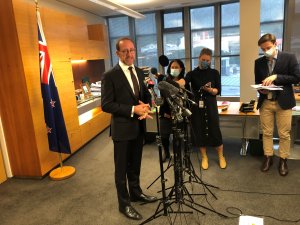Respiratory physician Lutz Beckert considers chronic obstructive pulmonary disease management, including the prevention of COPD, the importance of smoking cessation and pulmonary rehabilitation, and the lifesaving potential of addressing treatable traits. He also discusses the logic of inhaler therapy, moving from single therapy to dual and triple therapy when indicated, as well as other aspects of management
Pharmac moves on Māori health: Funding agency creates long-sought new Māori directorate
Pharmac moves on Māori health: Funding agency creates long-sought new Māori directorate

Gabrielle Baker looks back through the years since bureaucrats decided they ought to work on Māori health objectives
December is always a whirlwind. It is my least favourite month, despite my Christmas spirit, so it is hard to keep up with my interests outside of just making it to the point where I can put on my “out of office” for the holiday.
This is how I nearly – but not quite – missed the announcement from Pharmac that it has at last established a Māori health directorate.
As Trevor Simpson, Pharmac’s chief advisor Māori, said in the December media statement: “Creating the Māori directorate reflects the organisational response to the Pharmac Review while also acknowledging the many years of advocacy for a Māori directorate, both from internal Māori staff and our Māori stakeholders. It signals a critical shift towards building an organisation that is fit for purpose in the new health system.”
This is good news.
Although Pharmac has employed Māori advisors more or less since its establishment, there were literally only a couple and they were often spread through the organisation, without the benefit of being part of the same team (or having direction from the same manager), and without their own resource.
Effectively, the Māori advisors were given the task of influencing change, but without the tools to match.
So much remains outside of any Māori directorate’s control
It was only in 2020 that the first chief advisor Māori was appointed to the organisation. The chief advisor had a seat at the senior leadership team table, which increased their influence, to a degree. However, they still needed to rely on their ability to convince colleagues of the benefit of Māori health without their own team and without their own budget.
To explain further, there was, in fact, a Māori team but it reported to someone else. So there was some other resource for Māori health but it was small and dispersed, limiting its power within a Crown organisation.
In a report in 1993, Mason Durie and Hekia Parata, before the former became a professor and a knight, and the latter, an MP and Cabinet minister, considered the very question of the role of a Māori team.
The report assessed the then Department of Health’s capacity to meet its Māori health objectives and was carried out in the wake of the entire Māori health team resigning. Though there was not one single reason why everyone resigned, the report states it was “probably not” a coincidence.
The report is a treasure in its own way, articulating issues that the authors probably assumed would be solved by 2023. Shockingly, I still find aspects of it very relevant.
The authors saw government agencies grappling at the time with cultural responsiveness (which they describe as being “bicultural”) and Māori business interests.
The report seems to suggest it is cultural responsiveness that gets most attention, with the emphasis on how things are presented rather than how to improve core business.
As Tā Mason and Ms Parata put it: “[You] find in departments the focus being placed on human resource management processes such as composition of interview panels…or in presentational matters such as the logo…”
The report provides a list of ways government agencies have shown cultural responsiveness, including having a Māori name, carvings in the foyer, Māori signage, use of pōwhiri and karakia, te reo Māori lessons for staff, cultural courses at marae, recognition of a Māori staff network with time to meet during work hours, a designated Māori position in human resources and Māori cultural advisor(s) to the chief executive.
In listing these cultural responsiveness measures, the report makes it clear that these are good actions to take. They can make the workplace welcoming, and conversely their absence can make workplaces feel hostile.
I spent time in an organisation in the 2010s where work time to participate in a Māori staff network was difficult, and that was rough.
But, as inherently good as these measures are, they will not “effect the outcomes of the Government in the delivery of the department’s outputs”, says the report. It goes on to recommend structural changes to ensure Māori business interests (like strategic policy advice that is effective for Māori and good quality Te Tiriti o Waitangi analysis) could be met by the then Department of Health.
Specifically, the report recommends a Māori health group with a second-tier manager; more staff; and its own work programme and funding.
In other words, the report recommends the establishment of a Māori health directorate.
A Māori health directorate, Te Kete Hauora, was established in the 1990s following this report. And I was fortunate to spend lots of time working there.
The team in Te Kete Hauora and the work itself were great, but the ability to influence the wider organisation and health sector was limited by the wider organisational culture, changing priorities (that did not always reflect Māori health needs and aspirations) and issues like a budget that didn’t keep track with inflation (as was the case until recently with the Māori Provider Development Scheme).
A lack of organisation-wide buy-in also saw Te Kete Hauora disestablished in 2016. However, a new chief executive reinstated a Māori health directorate a couple of years later.
It’s this experience that makes me optimistic but extremely cautious about a Māori directorate. So much remains outside of any Māori directorate’s control.
I don’t have space here to delve into the issues of having a Māori health directorate where Māori aren’t the overall decision-makers. I acknowledge the potential of Te Aka Whai Ora in this regard, but I still apply this issue to all Crown organisations.
Organisations will have difficulties in recruiting an experienced Māori team when these skills are in hot demand. All in all, it will suffice to say any directorate will face considerable obstacles.
While establishing a Māori health directorate is only one, fairly commonplace, step towards having an organisation that truly reflects a modern understanding of Te Tiriti o Waitangi obligations, it is still cause for celebration that Pharmac has created one.
The directorate’s arrival shows that the many years of advocacy from Māori health professionals and Pharmac staff have led somewhere, and that Pharmac has taken on this advice from the review of the organisation that reported back last year.
In other words, it was not bad news to get in December, but the proof will be in how well supported the directorate is this year and beyond.
Gabrielle Baker (Ngāpuhi, Ngāti Kuri) is an independent health policy consultant
We're publishing this article as a FREE READ so it is FREE to read and EASY to share more widely. Please support us and the hard work of our journalists by clicking here and subscribing to our publication and website







![Barbara Fountain, editor of New Zealand Doctor Rata Aotearoa, and Paul Hutchison, GP and senior medical clinician at Tāmaki Health [Image: Simon Maude]](/sites/default/files/styles/thumbnail_cropped_100/public/2025-03/Barbara%20Fountain%2C%20editor%20of%20New%20Zealand%20Doctor%20Rata%20Aotearoa%2C%20and%20Paul%20Hutchison%2C%20GP%20and%20senior%20medical%20clinician%20at%20T%C4%81maki%20Health%20CR%20Simon%20Maude.jpg?itok=-HbQ1EYA)
![Lori Peters, NP and advanced health improvement practitioner at Mahitahi Hauora, and Jasper Nacilla, NP at The Terrace Medical Centre in Wellington [Image: Simon Maude]](/sites/default/files/styles/thumbnail_cropped_100/public/2025-03/2.%20Lori%20Peters%2C%20NP%20and%20advanced%20HIP%20at%20Mahitahi%20Hauora%2C%20and%20Jasper%20Nacilla%2C%20NP%20at%20The%20Terrace%20Medical%20Centre%20in%20Wellington%20CR%20Simon%20Maude.jpg?itok=sUfbsSF1)
![Ministry of Social Development health and disability coordinator Liz Williams, regional health advisors Mary Mojel and Larah Takarangi, and health and disability coordinators Rebecca Staunton and Myint Than Htut [Image: Simon Maude]](/sites/default/files/styles/thumbnail_cropped_100/public/2025-03/3.%20Ministry%20of%20Social%20Development%27s%20Liz%20Williams%2C%20Mary%20Mojel%2C%20Larah%20Takarangi%2C%20Rebecca%20Staunton%20and%20Myint%20Than%20Htut%20CR%20Simon%20Maude.jpg?itok=9ceOujzC)
![Locum GP Helen Fisher, with Te Kuiti Medical Centre NP Bridget Woodney [Image: Simon Maude]](/sites/default/files/styles/thumbnail_cropped_100/public/2025-03/4.%20Locum%20GP%20Helen%20Fisher%2C%20with%20Te%20Kuiti%20Medical%20Centre%20NP%20Bridget%20Woodney%20CR%20Simon%20Maude.jpg?itok=TJeODetm)
![Ruby Faulkner, GPEP2, with David Small, GPEP3 from The Doctors Greenmeadows in Napier [Image: Simon Maude]](/sites/default/files/styles/thumbnail_cropped_100/public/2025-03/5.%20Ruby%20Faulkner%2C%20GPEP2%2C%20with%20David%20Small%2C%20GPEP3%20from%20The%20Doctors%20Greenmeadows%20in%20Napier%20CR%20Simon%20Maude.jpg?itok=B0u4wsIs)
![Rochelle Langton and Libby Thomas, marketing advisors at the Medical Protection Society [Image: Simon Maude]](/sites/default/files/styles/thumbnail_cropped_100/public/2025-03/6.%20Rochelle%20Langton%20and%20Libby%20Thomas%2C%20marketing%20advisors%20at%20the%20Medical%20Protection%20Society%20CR%20Simon%20Maude.jpg?itok=r52_Cf74)
![Specialist GP Lucy Gibberd, medical advisor at MPS, and Zara Bolam, urgent-care specialist at The Nest Health Centre in Inglewood [Image: Simon Maude]](/sites/default/files/styles/thumbnail_cropped_100/public/2025-03/7.%20Specialist%20GP%20Lucy%20Gibberd%2C%20medical%20advisor%20at%20MPS%2C%20and%20Zara%20Bolam%2C%20urgent-care%20specialist%20at%20The%20Nest%20Health%20Centre%20in%20Inglewood%20CR%20Simon%20Maude.jpg?itok=z8eVoBU3)
![Olivia Blackmore and Trudee Sharp, NPs at Gore Health Centre, and Gaylene Hastie, NP at Queenstown Medical Centre [Image: Simon Maude]](/sites/default/files/styles/thumbnail_cropped_100/public/2025-03/8.%20Olivia%20Blackmore%20and%20Trudee%20Sharp%2C%20NPs%20at%20Gore%20Health%20Centre%2C%20and%20Gaylene%20Hastie%2C%20NP%20at%20Queenstown%20Medical%20Centre%20CR%20Simon%20Maude.jpg?itok=Z6u9d0XH)
![Mary Toloa, specialist GP at Porirua and Union Community Health Service in Wellington, Mara Coler, clinical pharmacist at Tū Ora Compass Health, and Bhavna Mistry, specialist GP at Porirua and Union Community Health Service [Image: Simon Maude]](/sites/default/files/styles/thumbnail_cropped_100/public/2025-03/9.%20Mary%20Toloa%2C%20Porirua%20and%20Union%20Community%20Health%20Service%20in%20Wellington%2C%20Mara%20Coler%2C%20T%C5%AB%20Ora%20Compass%20Health%2C%20and%20Bhavna%20Mistry%2C%20PUCHS%20CR%20Simon%20Maude.jpg?itok=kpChr0cc)